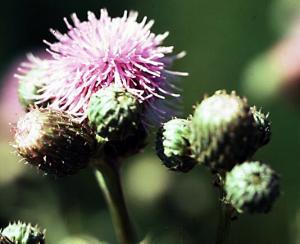CONTENTS
Registered Herbicides
[Return to weed
Identification]
[Return to Weed
Management]
[Home] |
|

General Description:
- grows upright with grooved stems 1-4
feet tall.
- deep and extensive root system with main roots running
horizontally 15 or more feet.
- roots may extend a meter under the soil surface.
- alternate leaves clasp the stem (no petioles) are cut
deeply into irregular lobes with spiny edges.
- Colony forming perennial that reproduces by seeds and
root buds on spreading lateral roots.
- Seedling: Cotyledons are oval and somewhat
fleshy. Germinating root buds do not have cotyledons. First true leaves are ovate with
soft spines.
- Juvenile: Early spring growth appears as
rosettes with irregularly lobed spiny tipped leaves. The degree of lobing, length of
spines and the amount of pubescence varies between plant.
- Mature: Has upright stems which can be woody
and grow 30cm to 2m tall. Stems are thin and green without spiny wings and are highly
branched above. Leaves are alternate and lance shaped with irregular lobes, and spines.
Mature plants have deep and extensive horizontal roots.
- Flower: Flowers are unisexual with male and
female flowers on separate plants. Flowers are small heads (½ to ¾ inches) of pink to
purple disk flowers, with spineless bracts.
Life cycle: perennial
- reproduces asexually from rhizamatous roots - any part
of the root system may give rise to new plants.
- also reproduces from wind-blown seed which germinate
late spring or early fall.
- brown seeds measure 1/8 inch, are long, generally
flattened and curved, and finely grooved lengthwise.
- seeds may retain viability 4 + years in the soil.
- new seedlings develop into
rosettes.
- purple flowers produced July - August.
- male and female flowers are on separate plants
(dioecious) and seed production requires both male and female plants be present.
Habitat/ Distribution:
- a problem in both perennial and annual crops,
rangeland, and minimum tillage systems.
- widely distributed throughout southern Canada and
northern United States.
- native to southeastern Eurasia and northern
Africa - introduced as crop contaminant during 18th century.
Impact on Yield:
Herbicide Control Notes:
- Basagran can be applied in summer without significant
crop injury, but might not be as effective as fall application of Stinger.
Ceutorhynchus litura (crown/root weevil)
Distribution within host range: limited sites
Infestation of host: light (>10%)
Control ability on seeds and/or plant density: Good
Availability for redistribution: Limited
Larinus planus (seed head weevil)
Distribution within host range: limited sites
Infestation of host: heavy (> 70%)
Control ability on seeds and/or plant density: fair
Availability for redistribution: mass collections
Rhinocyllus conicus (seed head weevil)
Distribution within host range: widespread
Infestation of host: heavy (> 70%)
Control ability on seeds and/or plant density: fair
Availability for redistribution: mass collections
Urophora cardui (stem gall fly)
Distribution within host range: widespread
Infestation of host: heavy (> 70%)
Control ability on seeds and/or plant density: fair
Availability for redistribution: mass collections
|

